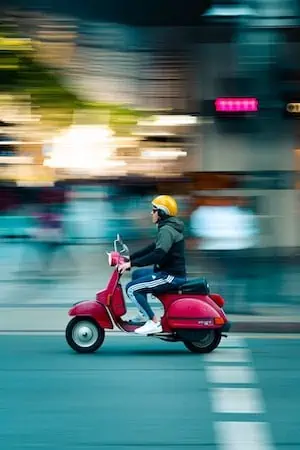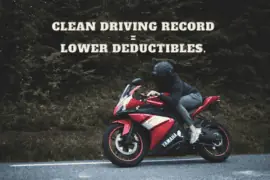For a long time, any two-wheeled vehicle was lumped into a general motorcycle classification. As engine sizes, bike speeds, and other features have entered the marketplace, the need for different classes developed.
Two common options that people ride today are scooters and mopeds.
Didn't You Try Our Quote Comparison Tool Yet? Save BIG by Doing it!
Knowing whether you have a scooter or a moped is essential because the licensing requirements could differ where you live. Insurance companies might offer different policies or rates based on this information.
Instead of paying more for what you need, let’s get you the information necessary to know the moped vs. scooter differences.
Table of Content
What Is a Scooter?
A scooter is like having a smaller motorcycle to ride. It uses a step-through design with an engine typically rated at 250cc or less with its displacement.
Some mopeds provide a pedal-assist option, but you won’t find that feature with a scooter.
This design typically comes with an automatic transmission, making it simple for most riders. A license plate is usually needed to operate on roads, and riders must have all the state-required safety equipment.
What Is a Moped?
A moped is a small, single-seat vehicle that offers foot pedals like a bicycle. It uses a small gasoline engine to provide enough speed for surface streets and residential areas but not for highways.
The difference between a moped and a motorized bicycle is often the engine size or the vehicle’s top speed.
Most mopeds have a 50cc engine or under and should come with headlights and turn signals. Step-through frames, bicycle stylings, and scooter-like options are on some makes and models.
How Does the Moped vs. Scooter Laws Vary in the United States?
Some states have specific laws that dictate how you can ride scooters and mopeds. Others group these vehicles into a motorcycle classification and require you to have a particular endorsement or driver’s license to operate them.
Here are some specific information points to review based on where you live.
- Some states have a minimum age requirement for operating mopeds or scooters. Most allow moped riders to manage them at 16, but this approach isn’t universal. You can be as young as 14 in Alabama, Alaska, Iowa, Kansas, North Dakota, and South Dakota.
- Licenses or endorsements are often necessary for scooters, especially if your model has a 250cc engine. It may be optional for some mopeds.
- Speed restrictions may apply. Delaware and Pennsylvania don’t allow electric scooters on any roads.
The motorcycle helmet laws for each state typically apply to mopeds and scooters, especially for young riders. Although a few local exceptions may exist, anyone under 18 must have a helmet and other mandated safety equipment.
Moped vs. Scooter: Speed Differences
Since a scooter can have an engine of up to 250cc, some models can reach speeds of up to 75 miles per hour. If you have a model with a 150cc engine, you can still hit about 60 MPH on the road.
With a scooter, you’ll use more fuel when you drive at faster speeds.
Some states restrict scooters from highways or interstates. You’ll need to review the horsepower and engine size minimums before using these roads to get to where you need to go.
A moped gets its name from the shortened description “motorized pedal vehicle.” Today’s designs use a step-through frame without pedals, but you can still see manufacturers creating options that look like bicycles.
Most mopeds achieve a top speed of 40 MPH or less. Entry-level options usually are at most 20 to 30 mph. These engines are fuel efficient, but they’re a low-speed option that limits where you can travel.
Price Differences Between Scooters and Mopeds
The cost differences between mopeds vs. scooters depend on the engine size. You’ll typically pay less when either vehicle is smaller and uses less displacement.
Some of the cheapest import mopeds are priced at less than $1,000, such as the TaoTao. If you want a Vespa Primavera, you can expect to pay around $4,000.
Scooters on the lower end of the engine displacement spectrum are priced similarly to high-end mopeds. You can pick up a road-legal 150cc model for about $3,000, although some TaoTao models have cut that cost to under $1,500.
A 250cc scooter with full motorcycle features can cost upwards of $10,000, but you’ll reach highway speeds with it.
Electric scooters are often priced like mopeds but have a limited range. Some models may get 25 to 40 miles before requiring a charge, which might not be enough distance for some riders.
Is Insurance Needed for Scooters or Mopeds?
Only 24 states currently require insurance for mopeds. It is also necessary for the District of Columbia.
Florida is the only state that doesn’t require insurance for scooters with an engine of at least 50cc or a top speed above 30 miles per hour. They’re put into the motorcycle classification at that point, which means you’ll need to meet the current liability minimums to operate the vehicle on public roads.
Although Florida doesn’t require insurance, riders must submit information about their financial accountability if an accident occurs. A liability policy is the easiest way to achieve this result, but you can file specific certificates with your local government that shows you have surety coverage.
In Nebraska, a vehicle is only classified as a moped if it has pedals. If you operate a step-through model, it will need insurance.
Use This Tool for Free and Save on Quotes!







